On the “Thixotropic” Behavior of Fresh Cement Pastes
Abstract
1. Introduction
2. Materials
3. Methods
3.1. Rheological Measurements
3.2. Isothermal Calorimetry
4. Results and Discussion
4.1. Thixotropy vs. Non-Reversible Structural Build-Up
4.2. Effect of the Superplasticizer on the Structural Build-Up
5. Conclusions
Author Contributions
Funding
Conflicts of Interest
Appendix A
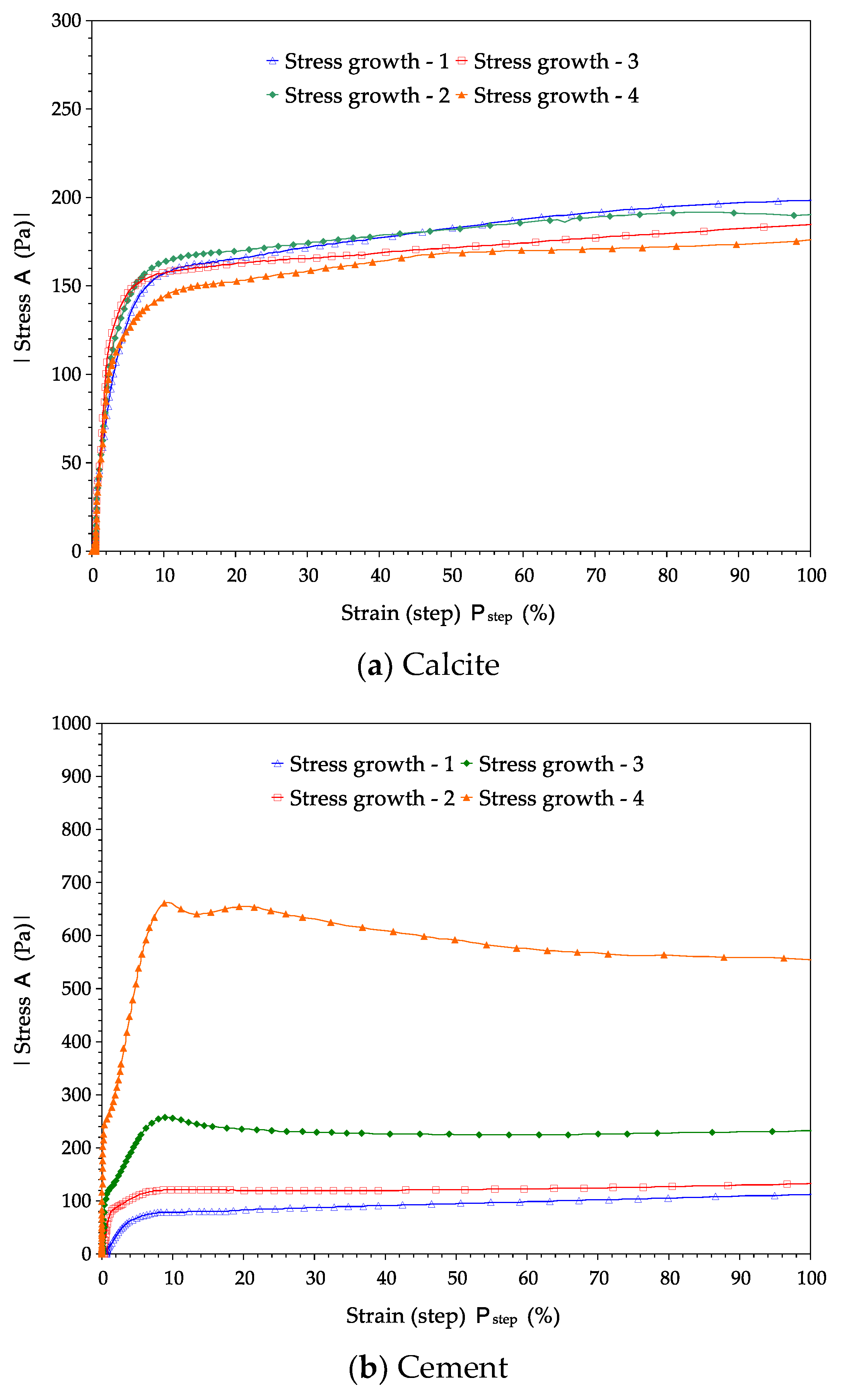
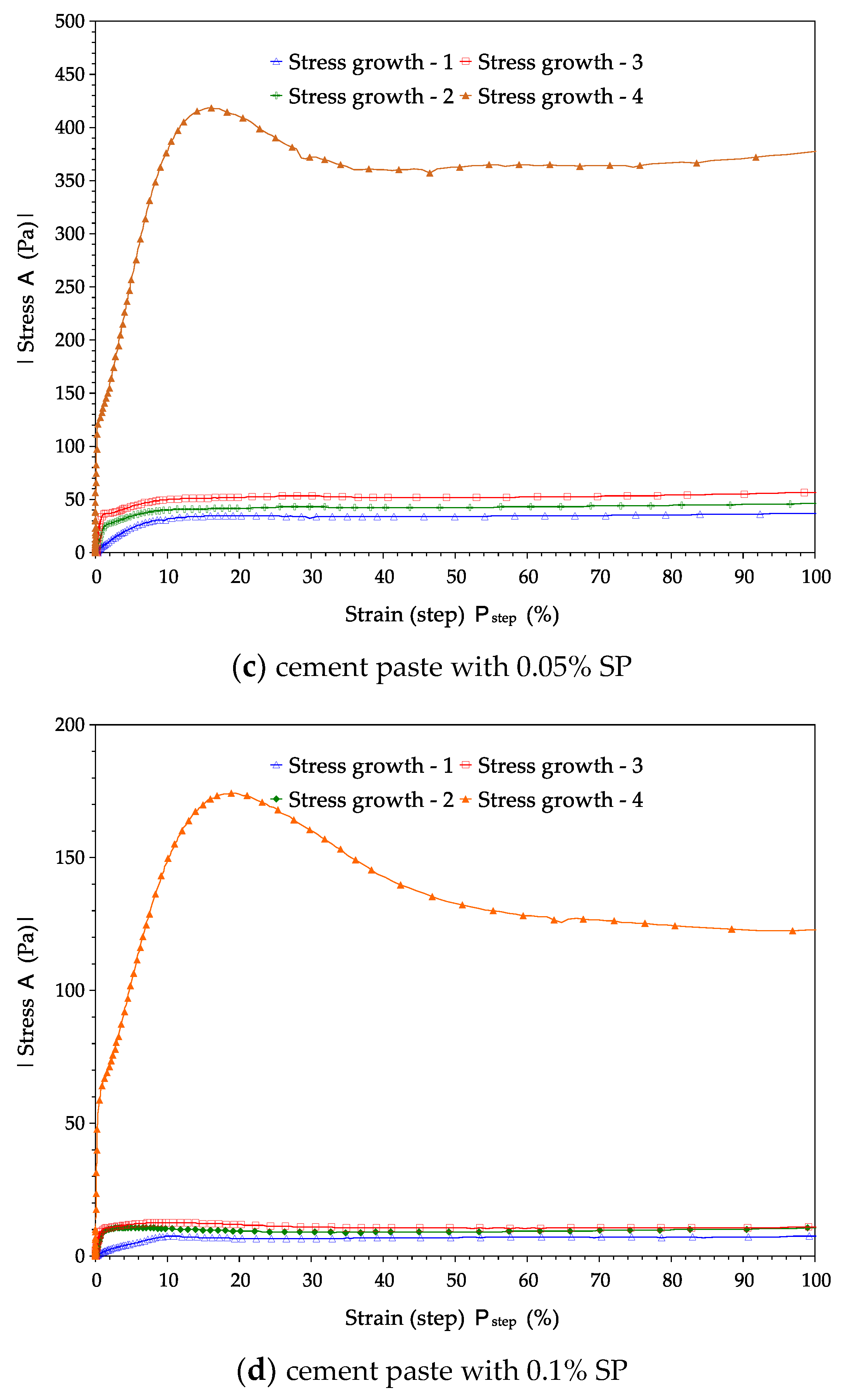


References
- Roussel, N.; Ovarlez, G.; Garrault, S.; Brumaud, C. The origins of thixotropy of fresh cement pastes. Cem. Concr. Res. 2012, 42, 148–157. [Google Scholar] [CrossRef]
- Barnes, H.A. Thixotropy—A review. J. Nonnewton. Fluid Mech. 1997, 70, 1–33. [Google Scholar] [CrossRef]
- Wallevik, J.E. Rheological properties of csement paste: Thixotropic behavior and structural breakdown. Cem. Concr. Res. 2009, 39, 14–29. [Google Scholar] [CrossRef]
- Roussel, N. Rheological requirements for printable concretes. Cem. Concr. Res. 2018, 112, 76–85. [Google Scholar] [CrossRef]
- Biricik, Ö.; Mardani, A. Parameters affecting thixotropic behavior of self compacting concrete and 3D printable concrete; a state-of-the-art review. Constr. Build. Mater. 2022, 339, 127688. [Google Scholar] [CrossRef]
- Kovler, K.; Roussel, N. Properties of fresh and hardened concrete. Cem. Concr. Res. 2011, 41, 775–792. [Google Scholar] [CrossRef]
- Bani Ardalan, R.; Joshaghani, A.; Hooton, R.D. Workability retention and compressive strength of self-compacting concrete incorporating pumice powder and silica fume. Constr. Build. Mater. 2017, 134, 116–122. [Google Scholar] [CrossRef]
- Lapasin, R.; Longo, V.; Rajgelj, S. Thixotropic behaviour of cement pastes. Cem. Concr. Res. 1979, 9, 309–318. [Google Scholar] [CrossRef]
- Yahia, A.; Mantellato, S.; Flatt, R.J. Concrete rheology: A basis for understanding chemical admixtures. In Science and Technology of Concrete Admixtures; Woodhead Publishing: Sawston, UK, 2016; pp. 97–127. ISBN 9780081006962. [Google Scholar]
- Roussel, N. Steady and transient flow behaviour of fresh cement pastes. Cem. Concr. Res. 2005, 35, 1656–1664. [Google Scholar] [CrossRef]
- Khayat, K.H.; Assaad, J.J. Effect of w/cm and High-Range Water-Reducing Admixture on Formwork Pressure and Thixotropy of Self-Consolidating Concrete. ACI Mater. J. 2006, 103, 186. [Google Scholar] [CrossRef]
- Roussel, N. Rheology of fresh concrete: From measurements to predictions of casting processes. Mater. Struct. Constr. 2007, 40, 1001–1012. [Google Scholar] [CrossRef]
- Banfill, P.F.G. A viscometric study of cement pastes containing superplasticizers with a note on experimental techniques. Mag. Concr. Res. 1981, 33, 37–47. [Google Scholar] [CrossRef]
- Petkova, V.; Samichkov, V. Some influences on the thixotropy of composite slag Portland cement suspensions with secondary industrial waste. Constr. Build. Mater. 2007, 21, 1520–1527. [Google Scholar] [CrossRef]
- Zhang, K.; Mezhov, A.; Schmidt, W. Chemical and thixotropic contribution to the structural build-up of cementitious materials. Constr. Build. Mater. 2022, 345, 128307. [Google Scholar] [CrossRef]
- Mostafa, A.M.; Yahia, A. New approach to assess build-up of cement-based suspensions. Cem. Concr. Res. 2016, 85, 174–182. [Google Scholar] [CrossRef]
- Kawashima, S.; Chaouche, M.; Corr, D.J.; Shah, S.P. Rate of thixotropic rebuilding of cement pastes modified with highly purified attapulgite clays. Cem. Concr. Res. 2013, 53, 112–118. [Google Scholar] [CrossRef]
- Schultz, M.A.; Struble, L.J. Use of oscillatory shear to study flow behavior of fresh cement paste. Cem. Concr. Res. 1993, 23, 273–282. [Google Scholar] [CrossRef]
- Mahaut, F.; Mokéddem, S.; Chateau, X.; Roussel, N.; Ovarlez, G. Effect of coarse particle volume fraction on the yield stress and thixotropy of cementitious materials. Cem. Concr. Res. 2008, 38, 1276–1285. [Google Scholar] [CrossRef]
- Otsubo, Y.; Miyai, S.; Umeya, K. Time-dependent flow of cement pastes. Cem. Concr. Res. 1980, 10, 631–638. [Google Scholar] [CrossRef]
- Roussel, N. A thixotropy model for fresh fluid concretes: Theory, validation and applications. Cem. Concr. Res. 2006, 36, 1797–1806. [Google Scholar] [CrossRef]
- Pourchet, S.; Pochard, I.; Brunel, F.; Perrey, D. Chemistry of the calcite/water interface: Influence of sulfate ions and consequences in terms of cohesion forces. Cem. Concr. Res. 2013, 52, 22–30. [Google Scholar] [CrossRef]
- Tramaux, A.; Azéma, N.; El Bitouri, Y.; David, G.; Negrell, C.; Poulesquen, A.; Haas, J.; Remond, S. Synthesis of phosphonated comb-like copolymers and evaluation of their dispersion efficiency on CaCO3 suspensions part II: Effect of macromolecular structure and ionic strength. Powder Technol. 2018, 334, 163–172. [Google Scholar] [CrossRef]
- Mikanovic, N.; Khayat, K.; Pagé, M.; Jolicoeur, C. Aqueous CaCO3 dispersions as reference systems for early-age cementitious materials. Colloids Surfaces A Physicochem. Eng. Asp. 2006, 291, 202–211. [Google Scholar] [CrossRef]
- Aït-Kadi, A.; Marchal, P.; Choplin, L.; Chrissemant, A.S.; Bousmina, M. Quantitative analysis of mixer-type rheometers using the couette analogy. Can. J. Chem. Eng. 2002, 80, 1166–1174. [Google Scholar] [CrossRef]
- Dzuy, N.Q.; Boger, D.V. Direct Yield Stress Measurement with the Vane Method. J. Rheol. 1985, 29, 335–347. [Google Scholar] [CrossRef]
- El Bitouri, Y.; Azéma, N. Potential Correlation between Yield Stress and Bleeding. In Proceedings of the SP-349: 11th ACI/RILEM International Conference on Cementitious Materials and Alternative Binders for Sustainable Concrete, Online, 7–10 June 2021; American Concrete Institute: Farmington Hills, MI, USA, 2022; Volume 349, pp. 479–494. [Google Scholar]
- Roussel, N.; Lemaître, A.; Flatt, R.J.; Coussot, P. Steady state flow of cement suspensions: A micromechanical state of the art. Cem. Concr. Res. 2010, 40, 77–84. [Google Scholar] [CrossRef]
- Flatt, R.; Schober, I. Superplasticizers and the Rheology of Concrete; Woodhead Publishing Limited: Sawston, UK, 2011; ISBN 9780857090287. [Google Scholar]
- Houst, Y.F.; Flatt, R.J.; Bowen, P.; Hofmann, H.; Mader, U.; Widmer, J.; Sulser, U.; Bürge, T.A. Influence of Superplasticizer Adsorption on the Rheology of Cement Paste. In Proceedings of the International RILEM Conference on “The Role of Admixtures in High Performance Concrete”, Monterrey, Mexico, 21–26 March 1999; pp. 387–402, ISBN 2-912143-05-5. [Google Scholar]
- Yoshioka, K.; Sakai, E.; Daimon, M.; Kitahara, A. Role of steric hindrance in the performance of superplasticizers for concrete. J. Am. Ceram. Soc. 1997, 80, 2667–2671. [Google Scholar] [CrossRef]
- Hanehara, S.; Yamada, K. Interaction between cement and chemical admixture from the point of cement hydration, absorption behaviour of admixture, and paste rheology. Cem. Concr. Res. 1999, 29, 1159–1165. [Google Scholar] [CrossRef]
- Plank, J.; Sakai, E.; Miao, C.W.; Yu, C.; Hong, J.X. Chemical admixtures—Chemistry, applications and their impact on concrete microstructure and durability. Cem. Concr. Res. 2015, 78, 81–99. [Google Scholar] [CrossRef]
- Nkinamubanzi, P.C.; Mantellato, S.; Flatt, R.J. Superplasticizers in practice. In Science and Technology of Concrete Admixtures; Woodhead Publishing: Sawston, UK, 2016; pp. 353–377. ISBN 9780081006962. [Google Scholar]
- Marchon, D.; Flatt, R.J. Impact of chemical admixtures on cement hydration. In Science and Technology of Concrete Admixtures; Woodhead Publishing: Sawston, UK, 2016; pp. 279–304. ISBN 9780081006962. [Google Scholar]
- Zhu, W.; Feng, Q.; Luo, Q.; Bai, X.; Lin, X.; Zhang, Z. Effects of pce on the dispersion of cement particles and initial hydration. Materials 2021, 14, 3195. [Google Scholar] [CrossRef] [PubMed]
- Singh, N.B.; Sarvahi, R.; Singh, N.P. Effect of superplasticizers on the hydration of cement. Cem. Concr. Res. 1992, 22, 725–735. [Google Scholar] [CrossRef]
- Flatt, R.J. Dispersion forces in cement suspensions. Cem. Concr. Res. 2004, 34, 399–408. [Google Scholar] [CrossRef]
- Flatt, R.J.; Bowen, P. Yodel: A yield stress model for suspensions. J. Am. Ceram. Soc. 2006, 89, 1244–1256. [Google Scholar] [CrossRef]
- Hesse, C.; Goetz-Neunhoeffer, F.; Neubauer, J. A new approach in quantitative in-situ XRD of cement pastes: Correlation of heat flow curves with early hydration reactions. Cem. Concr. Res. 2011, 41, 123–128. [Google Scholar] [CrossRef]
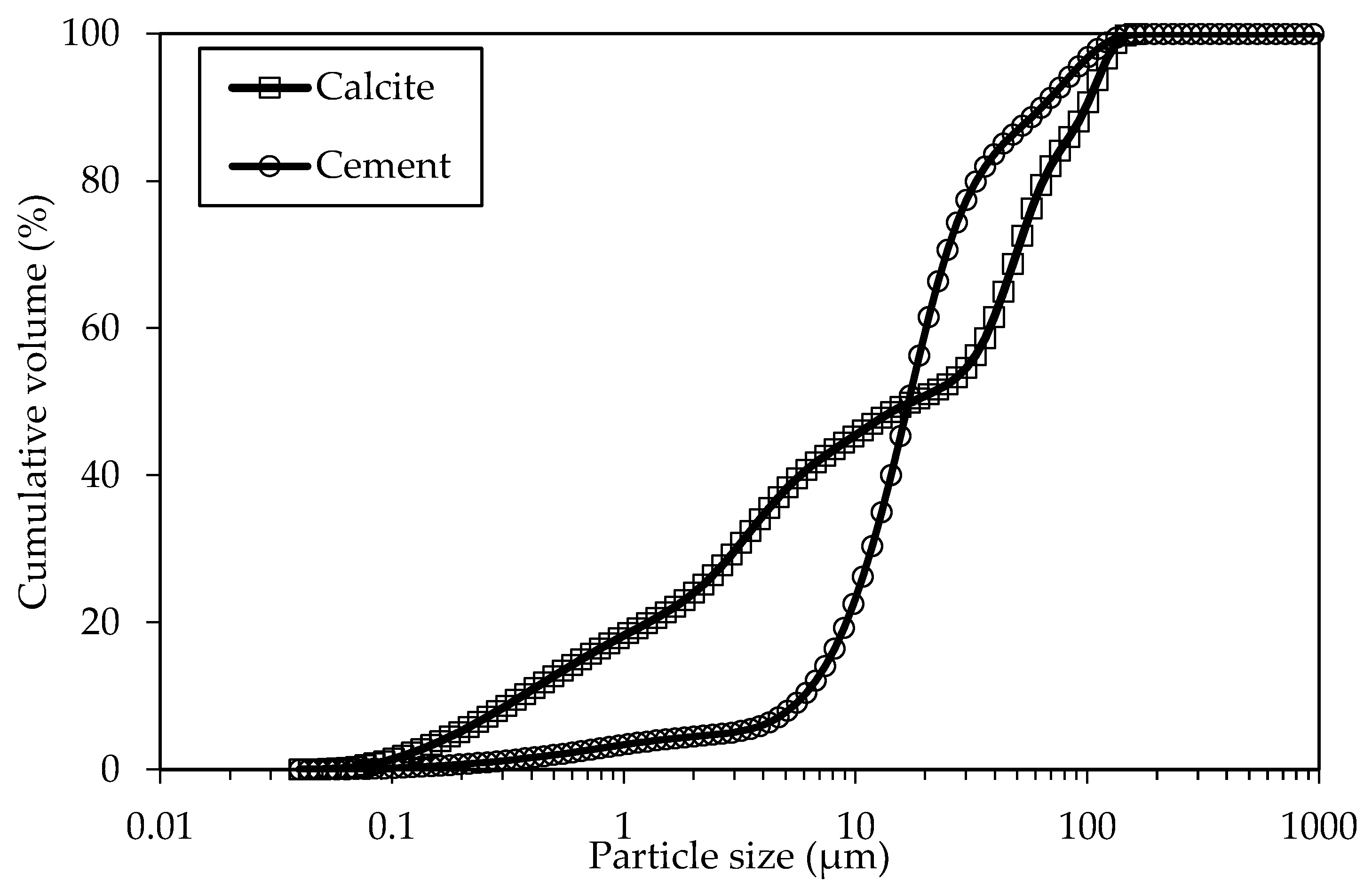
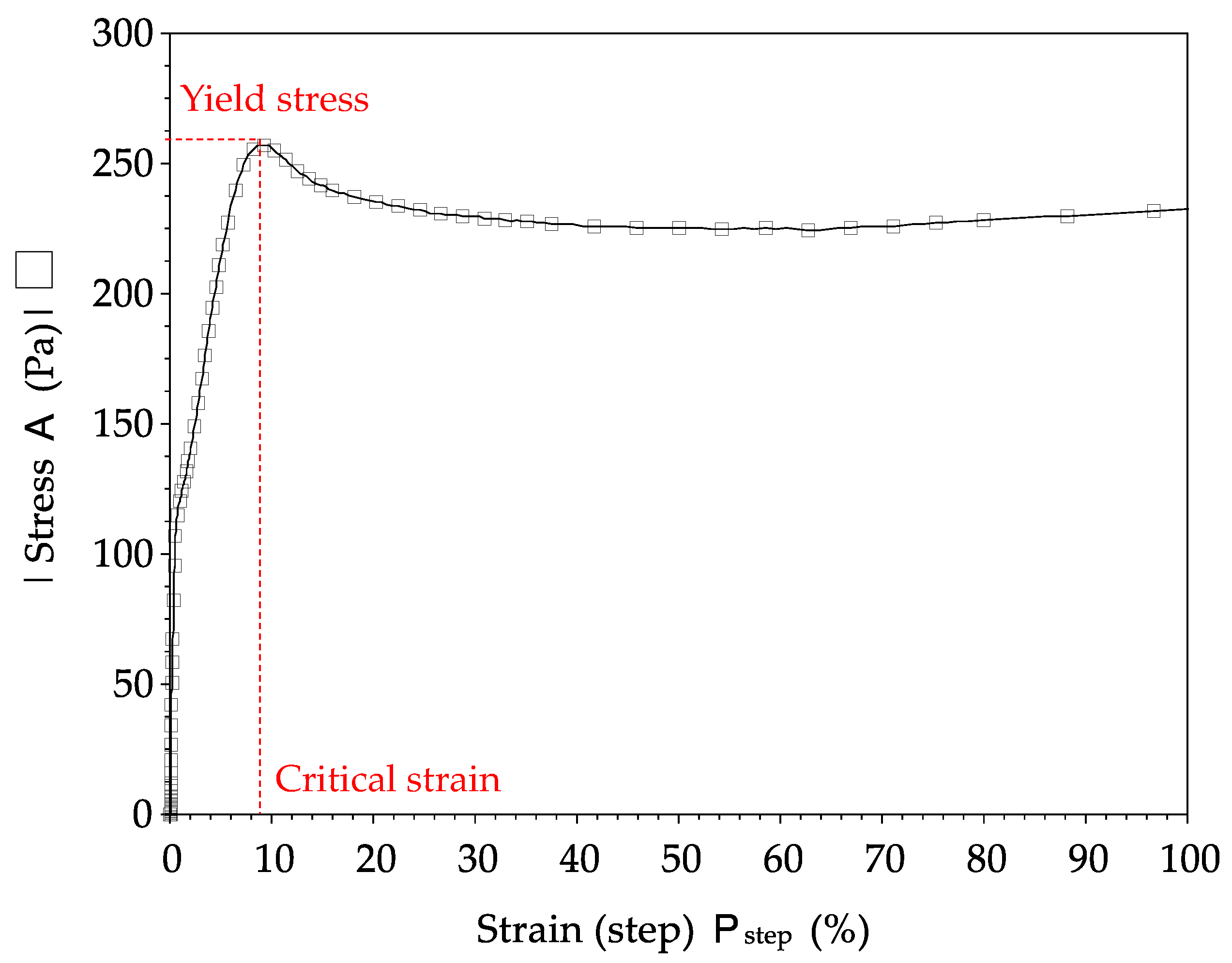
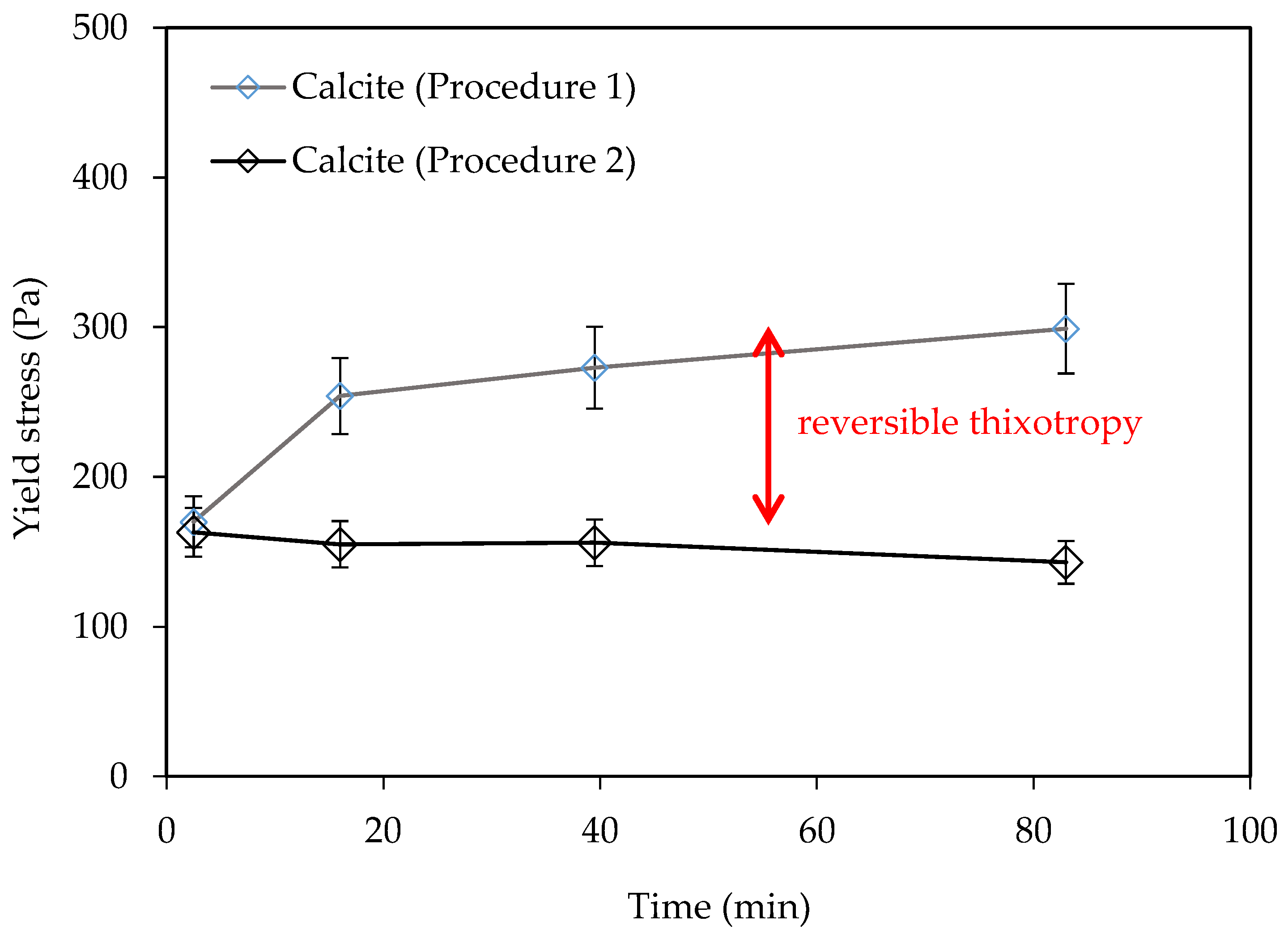


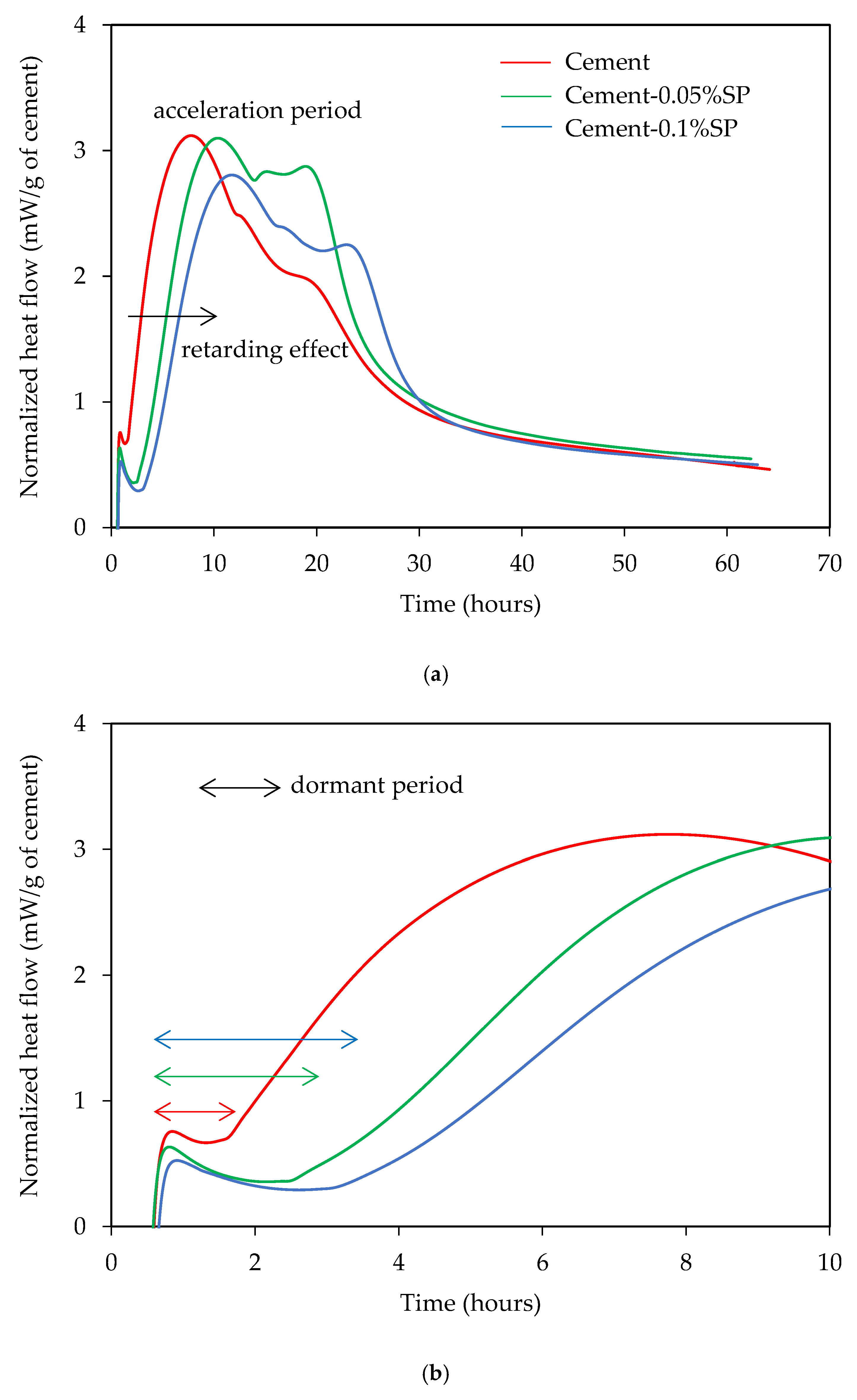
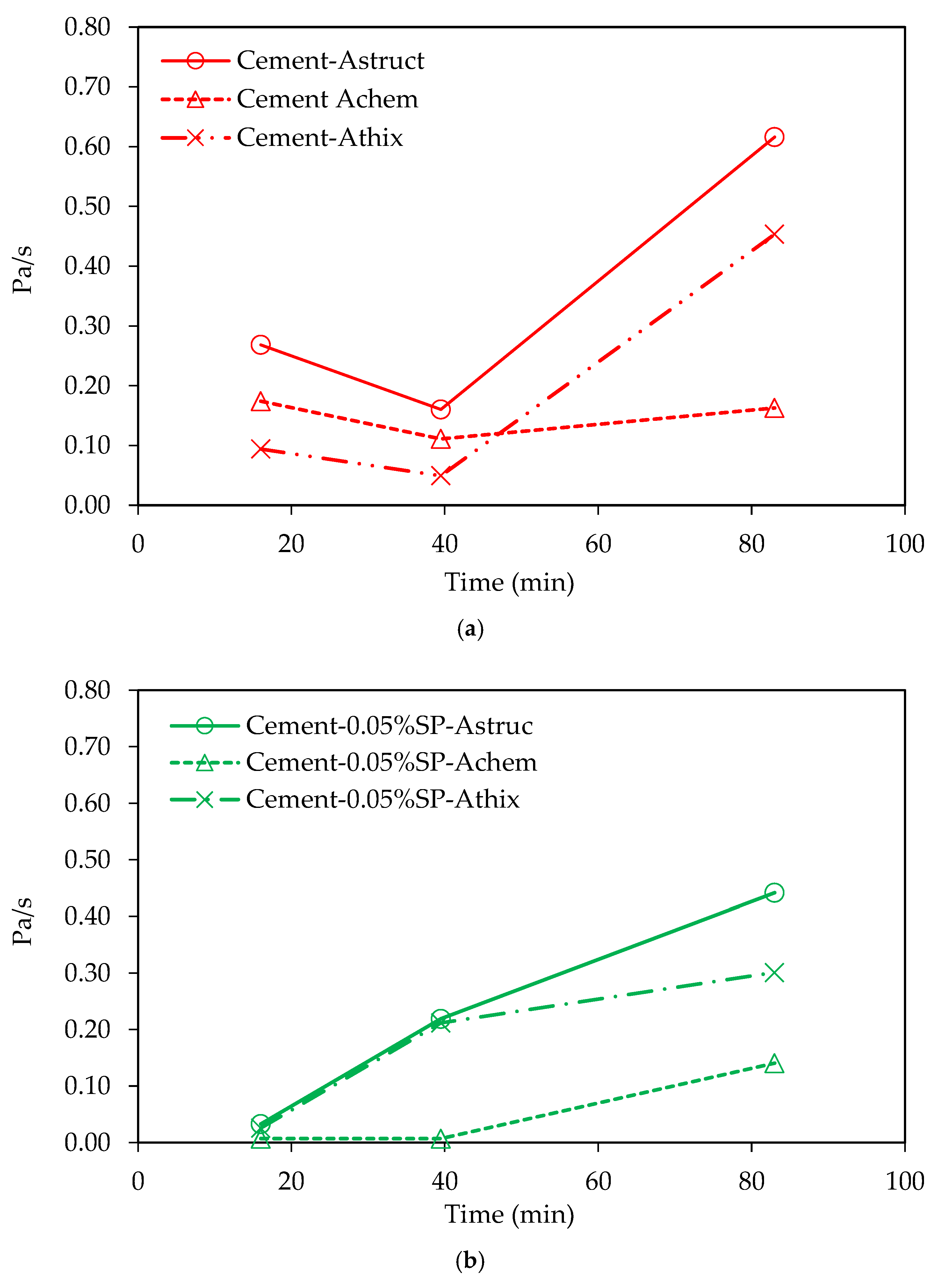
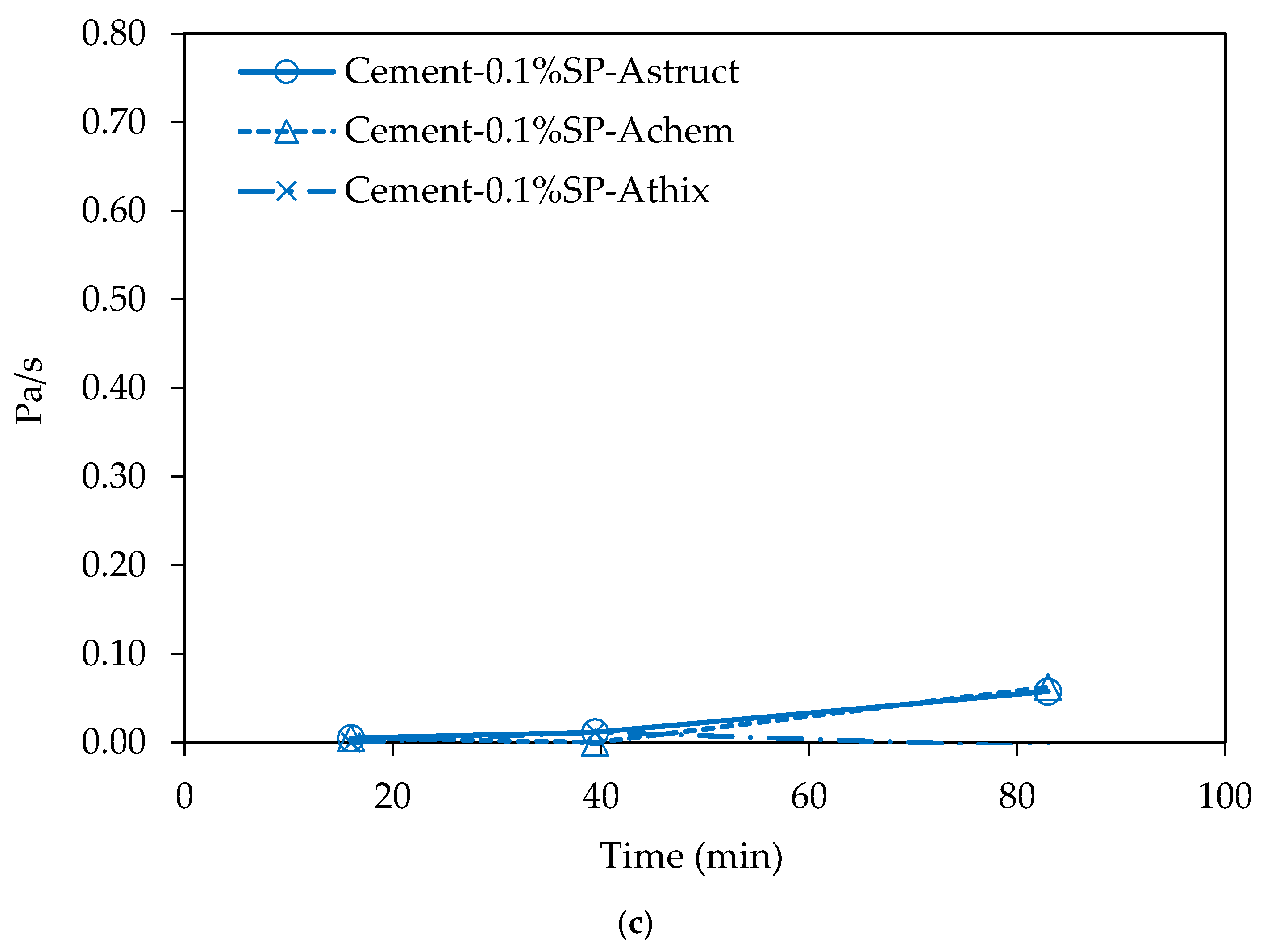
| Parameter | Cement | Calcite |
|---|---|---|
| Mean diameter (µm) | 21.2 | 37.9 |
| d10 (µm) | 3.9 | 0.4 |
| d50 (µm) | 15.3 | 19.2 |
| d90 (µm) | 45.6 | 108.4 |
| Density (g/cm3) | 3.14 | 2.75 |
| Blaine-specific surface (cm2/g) | 4420 | - |
| BET-specific surface (m2/g) | - | 2.25 |
| Time (min) | Hydration Time (min) | Procedure | Shear Rate (s−1) | Duration (s) |
|---|---|---|---|---|
| 0.0 | 7 | Pre-shear | 100 | 30 |
| 0.5 | 7.5 | Resting time | 0 | 120 |
| 2.5 | 9.5 | Stress growth 1 | 0.01 | 180 |
| 6.0 | 13.0 | Resting time | 0 | 630 |
| 16.0 | 23.0 | Stress growth 2 | 0.01 | 180 |
| 19.5 | 26.5 | Resting time | 0 | 1230 |
| 39.5 | 46.5 | Stress growth 3 | 0.01 | 180 |
| 43.0 | 50.0 | Resting time | 0 | 2430 |
| 83.0 | 90.0 | Stress growth 4 | 0.01 | 180 |
| Time (min) | Hydration Time (min) | Procedure | Shear Rate (s−1) | Duration (s) |
|---|---|---|---|---|
| 0.0 | 7 | Pre-shear | 100 | 30 |
| 0.5 | 7.5 | Resting time | 0 | 120 |
| 2.5 | 9.5 | Stress growth 1 | 0.01 | 180 |
| 5.5 | 12.5 | Pre-shear | 100 | 30 |
| 6.0 | 13.0 | Resting time | 0 | 600 |
| 16.0 | 23.0 | Stress growth 2 | 0.01 | 180 |
| 19.0 | 26.0 | Pre-shear | 100 | 30 |
| 19.5 | 26.5 | Resting time | 0 | 1200 |
| 39.5 | 46.5 | Stress growth 3 | 0.01 | 180 |
| 42.5 | 49.5 | Pre-shear | 100 | 30 |
| 43.0 | 50.0 | Resting time | 0 | 2400 |
| 83.0 | 90.0 | Stress growth 4 | 0.01 | 180 |
Publisher’s Note: MDPI stays neutral with regard to jurisdictional claims in published maps and institutional affiliations. |
© 2022 by the authors. Licensee MDPI, Basel, Switzerland. This article is an open access article distributed under the terms and conditions of the Creative Commons Attribution (CC BY) license (https://creativecommons.org/licenses/by/4.0/).
Share and Cite
El Bitouri, Y.; Azéma, N. On the “Thixotropic” Behavior of Fresh Cement Pastes. Eng 2022, 3, 677-692. https://doi.org/10.3390/eng3040046
El Bitouri Y, Azéma N. On the “Thixotropic” Behavior of Fresh Cement Pastes. Eng. 2022; 3(4):677-692. https://doi.org/10.3390/eng3040046
Chicago/Turabian StyleEl Bitouri, Youssef, and Nathalie Azéma. 2022. "On the “Thixotropic” Behavior of Fresh Cement Pastes" Eng 3, no. 4: 677-692. https://doi.org/10.3390/eng3040046
APA StyleEl Bitouri, Y., & Azéma, N. (2022). On the “Thixotropic” Behavior of Fresh Cement Pastes. Eng, 3(4), 677-692. https://doi.org/10.3390/eng3040046







